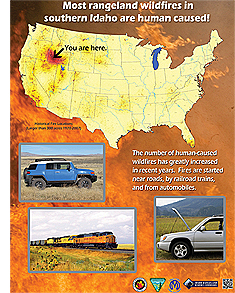
Agency creates signs to warn I-84 motorists of fire danger
Steve Stuebner
Careless people flicking a burning cigarette butt out the window, flaming bits of rubber from flat tires, ignitions from target-shooting and sparks from railroad cars have ignited more than 135 human-caused range fires in southern Idaho so far in the summer of 2012, leading to the destruction of more than 35,000 acres of rangeland habitat.
 In hopes of reversing this trend, the Idaho Rangeland Resource Commission (IRRC) has financed the creation of several large, color multi-panel signs that were installed this week at two rest areas along Interstate 84 – one near the Black's Creek exit east of Boise and another near Bliss. The signs will help educate motorists on the freeway about the impacts of human-caused fires.
In hopes of reversing this trend, the Idaho Rangeland Resource Commission (IRRC) has financed the creation of several large, color multi-panel signs that were installed this week at two rest areas along Interstate 84 – one near the Black's Creek exit east of Boise and another near Bliss. The signs will help educate motorists on the freeway about the impacts of human-caused fires.
"All it takes is someone tossing a burning cigarette out the window of a car to ignite a wildfire that can do a huge amount of damage to Idaho's rangelands," said Gretchen Hyde, Executive Director of the Idaho Rangeland Resource Commission, a state agency. "Once the native shrub-steppe habitat burns, cheatgrass and other non-native annual weeds move in, making the area even more vulnerable to catching fire again.
It's a vicious cycle that needs to be stopped. We hope that our educational signs will help motorists understand the need to use their ashtrays when putting out a cigarette or avoid other actions such as careless shooting.”
Wildfires are bad for Idaho's rangelands because they burn perennial grasses and sagebrush that is critical for wildlife, such as sage-grouse and wintering mule deer. Many ranchers in Idaho also depend on public and private rangelands for raising livestock. Wildfires can cause big financial losses for ranchers, Hyde says. That negatively affects Idaho’s rural economies.
The IRRC also is exploring long-term solutions to restoring repeatedly burned rangelands that are now full of cheatgrass and noxious weeds. Some of those solutions include:
-
Timely implementation of targeted livestock grazing to reduce existing fine fuels such cheatgrass. This concept surfaced during a February 2011 range fire symposium in Boise. Targeted grazing with sheep and goats is a tool widely used by land and park managers to reduce noxious weeds. The same approach with cattle could be used to target cheatgrass at no extra cost to the taxpayer. "The key is to give land managers the flexibility to use targeted grazing in a timely manner to prevent range fires," Hyde said.
-
Plant green strips. The Bureau of Land Management has experimented with green strip projects to create fire breaks on public lands to help stop range fires. Green strips are typically planted with crested wheatgrass or forage kochia. Green strips with crested wheatgrass need to be grazed properly to avoid creating a fire hazard. The green strips provide winter feed to wildlife as well.
-
Set priorities for protecting high-quality shrub-steppe habitat (such as core habitat areas for sage-grouse) and focus firefighting efforts on those areas to preserve the habitat.
"If we're trying to prevent the listing of sage-grouse – clearly that's a priority in our state – then we should be putting a priority on protecting that habitat," Hyde said. "Fire is a primary threat to sage-grouse habitat. Protecting quality habitat for sage-grouse benefits a lot of other species."
The IRRC thanked the Idaho Transportation Department, Bureau of Land Management, National Interagency Fire Center and the Magic Valley Cattle Association for assistance in producing the education signs.
For more information about the Idaho Rangeland Resource Commission's I-84 sign project, see the agency's website.
Published 8-31-2012